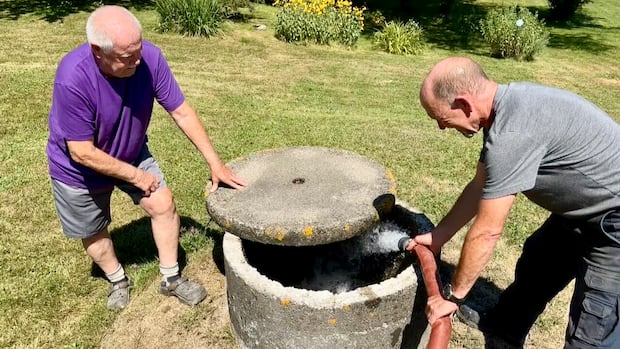[published_date]
As the sun beat down on their house in central Nova Scotia last weekend, Brian Wilson’s teenage daughter turned on the tap, but no water came out.
“That led me to start investigating what the cause was and we determined upon opening the hatch to the well that we were empty,” Wilson said of their home in Stewiacke, N.S., roughly 70 kilometres northwest of Halifax.
“Then I thought, we’ll just flip over to the cistern. It’s always been able to supply us during dry times. But we determined that it was also empty.”
The Wilsons are not alone.
Across the province, wells and reservoirs are drying up and municipalities are implementing conservation measures amid a drought with no end in sight.
Wilson said he called several water delivery companies that operate in his rural area, but didn’t have much luck.
“One of them was so backed up that they’ve stopped taking calls and … the one supplier that we’re hoping is going to show up told us it would be at least a week before they could get to us,” he told Information Morning Nova Scotia.
“Life smacked us.”
Delivery trucks are working more than 12 hours a day, seven days a week, just to keep up with the desperate calls for water. Preston Mulligan has the story.
With no running water at home, the family was forced to leave. They headed to their camp roughly 45 minutes away.
“At least now we have drinking water and can take showers,” he said.
The Town of Stewiacke has implemented water conservation measures that include no watering of gardens, lawns or trees, no washing vehicles or homes, and no filling swimming pools or running sprinklers.
The area gets its water mainly from the St. Andrews River, which is at the lowest level it’s been since officials started monitoring it 10 years ago, according to the town.
CAO Marc Seguin said the town is monitoring the river daily.
“We have contingency plans in place should the river levels not be sufficient to supply our water demands,” he said.
“Contingency plans would involve having to truck water in to supply those systems, but we’re not at a stage where we have to look at that.”
Mandatory water conservation measures are also in place in Annapolis County and Antigonish. Halifax Regional Municipality has made conservation measures voluntary for now.
Water conservation notices have been issued in Stewiacke, Stellarton, West Hants and the Municipality of the District of Yarmouth and Queens.

On the southwestern tip of the province, the sound of tumbling clothes is heard all day long at a laundromat in Yarmouth.
Helen Muise, who works at K.D. Wash and Dry Laundry, said people whose wells have run dry are flocking to the business to wash their clothes.
“Our washer and dryers do not stop. They are full from the time we open in the morning at 8 a.m. until the time we close at 6 p.m.,” said Muise, adding that some customers are even travelling upward of 100 kilometres one-way from places like Shelburne, Barrington, Digby and Clare.
According to the provincial government, 46 per cent of Nova Scotians rely primarily on groundwater from dug or drilled wells for their private supply of water.
Gordon Check, a senior hydrogeologist with the province’s Department of Environment and Climate Change, said there is a natural cycle in groundwater and a natural decline in water levels every year during the summer, followed by a recharge period in the fall and winter.
“It’s a fairly natural condition, however this year does seem to be particularly dry,” he told Information Morning Cape Breton.
He said people with shallow wells should try to conserve water by using only the water needed for daily purposes.

In the long term, those experiencing frequent water shortages could consider deepening their well or replacing a shallow well with a deeper drilled well, said Check. Installing a water storage container like a cistern could also be an option, he added.
The province said seven provincial parks are providing drinking water and showers between 1:30 p.m. and 3:30 p.m. daily. They are:
• Blomidon
• Ellenwood Lake
• Graves Island
• Porters Lake
• Rissers Beach
• The Islands
• Valleyview
CBC meteorologist Ryan Snoddon said there isn’t much help in the forecast. He says the next chance for showers isn’t until late next week.
Snoddon said the last time the province saw a widespread substantial rain was on June 7 and 8.
The last time Nova Scotia had substantial rain across the province was in early June. CBC meteorologist Ryan Snoddon says our next chance of rain likely won’t come until late next week.
The dry conditions have also prompted the province to ban open fires and activities in the woods such as hiking, camping, fishing and driving ATVs. Camping is still allowed at campgrounds.





